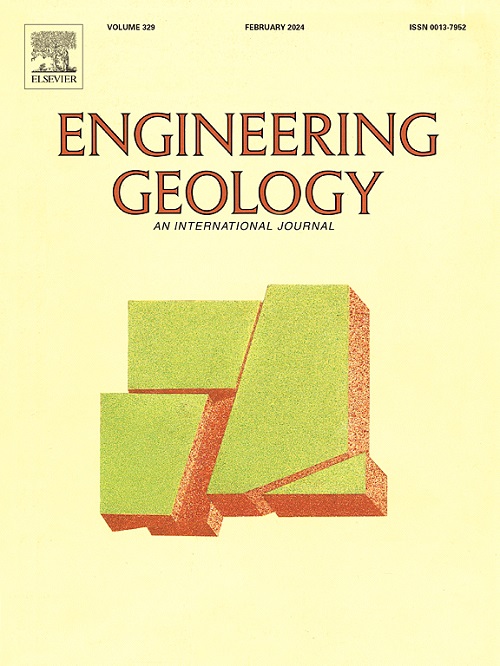Indoor tests of sensor-enabled piezoelectric geocable–geogrid composite structure for slope rehabilitation and monitoring
IF 8.4
1区 工程技术
Q1 ENGINEERING, GEOLOGICAL
引用次数: 0
Abstract
Sensor-enabled piezoelectric geocables were combined with a geogrid to acquire a sensor-enabled piezoelectric geogrid (SPGG) based on the impedance–strain relationship. Tension, pullout, and straight shear tests were conducted on this SPGG configuration. The tension test results indicated that the tensile strain–normalized impedance curves were exponential in form within the first 7 % of strain and the rate of shift in impedance was independent of the tension loading rate. An excellent correspondence between the peak strength and impedance inflection point was observed in the results of the pullout and straight shear tests. Additional validation of the proposed SPGG was conducted through a collapse test of the reinforced soil slope model. The results indicated that the SPGG-obtained strains were similar to actual strain gauge measurements but provided a larger measurement range and that the SPGG was able to sense real-time vibrations during the slope collapse using a voltage analysis, confirming that the proposed SPGG can simultaneously provide soil reinforcement, strain monitoring of reinforcement materials, and vibration sensing. This research is expected to inform the development of a dynamic and static monitoring, large range, and accurate method for monitoring the conditions of reinforced soil over their entire lifecycles.
用于斜坡修复和监测的传感器压电土工材料-土工格栅复合结构的室内试验
传感器压电土工电缆与土工格栅相结合,获得了基于阻抗-应变关系的传感器压电土工格栅(SPGG)。对这种 SPGG 配置进行了拉伸、拉出和直剪试验。拉伸试验结果表明,拉伸应变归一化阻抗曲线在前 7% 的应变范围内呈指数形式,阻抗变化率与拉伸加载速率无关。拉伸和直剪试验结果表明,峰值强度与阻抗拐点之间存在极好的对应关系。通过对加固土坡模型进行坍塌试验,对提出的 SPGG 进行了进一步验证。结果表明,SPGG 获得的应变与实际应变计测量结果相似,但测量范围更大,而且 SPGG 能够通过电压分析实时感知斜坡坍塌过程中的振动,这证实了所提出的 SPGG 可同时提供土壤加固、加固材料应变监测和振动感知功能。这项研究有望为开发一种动态和静态监测、大范围和精确的方法提供信息,以监测加固土壤在其整个生命周期内的状况。
本文章由计算机程序翻译,如有差异,请以英文原文为准。
求助全文
约1分钟内获得全文
求助全文
来源期刊

Engineering Geology
地学-地球科学综合
CiteScore
13.70
自引率
12.20%
发文量
327
审稿时长
5.6 months
期刊介绍:
Engineering Geology, an international interdisciplinary journal, serves as a bridge between earth sciences and engineering, focusing on geological and geotechnical engineering. It welcomes studies with relevance to engineering, environmental concerns, and safety, catering to engineering geologists with backgrounds in geology or civil/mining engineering. Topics include applied geomorphology, structural geology, geophysics, geochemistry, environmental geology, hydrogeology, land use planning, natural hazards, remote sensing, soil and rock mechanics, and applied geotechnical engineering. The journal provides a platform for research at the intersection of geology and engineering disciplines.
 求助内容:
求助内容: 应助结果提醒方式:
应助结果提醒方式:


